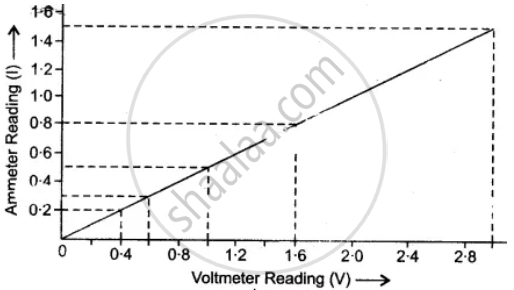Advertisements
Advertisements
Question
From the following observations taken while determining the resistance of a conductor, draw the current-voltage graph and calculate the resistance of conductor. Is the conductor ohmic?
| Ammeter reading I (in ampere) | Voltmeter reading V (in volt) |
| 0.2 | 0.4 |
| 0.3 | 0.6 |
| 0.5 | 1.0 |
| 0.8 | 1.6 |
| 1.5 | 3.0 |
Solution
The current-voltage graph is shown in figure.

Resistance R = `(triangle"V")/(triangle"I")`
`= ((3.0 - 0.6)"V")/((1.5 - 0.3)"A")`
`= (2.4"V")/(1.2"A") = 2 Omega`
The conductor is ohmic.
APPEARS IN
RELATED QUESTIONS
State whether the resistivity of a wire changes with the change in the thickness of the wire.
What do the letters p.d. stand for?
Potential difference is measured in _________ by using a ___________ placed in ___________ across a component.
The p.d. across a lamp is 12 V. How many joules of electrical energy are changed into heat and light when:
a charge of 5 C passes through it?
A potential difference of 20 volts is applied across the ends of a resistance of 5 ohms. What current will flow in the resistance?
Calculate the current flowing through each of the resistors A and B in the circuit shown in the following figure.

Suppose there are three resistors A, B, and C having resistances r1, r2, and r3 respectively. If R represents their equivalent resistance, establish the following relation `1/"R" = 1/"r"_1 + 1/"r"_2 + 1/"r"_3`, when joined in parallel.
A current of 0.2 A flows through a conducting wire for 5 minutes. How much charge will flow?
Which of the following represents voltage?
How will you conclude that the same potential difference (voltage) exists across three resistors connected in a parallel arrangement to a battery?
